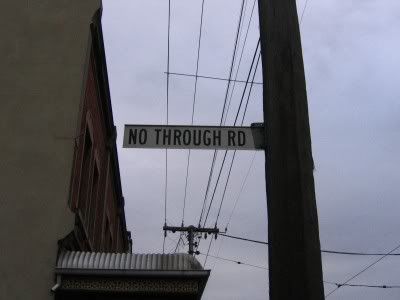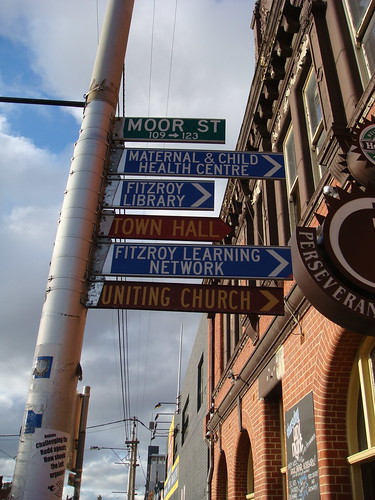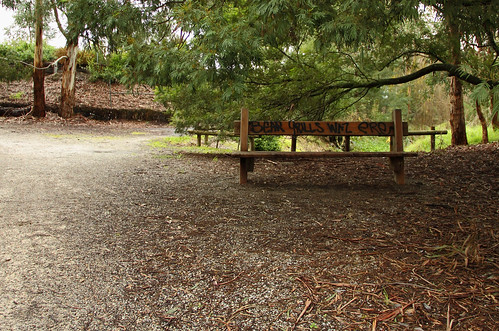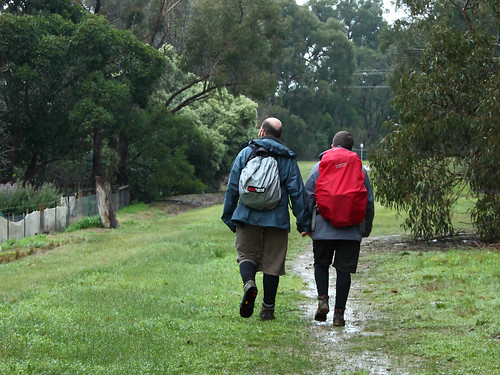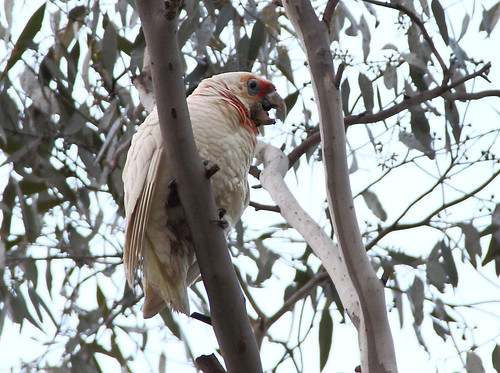Anyway, here is the map of our 2 day walk: click for map. I wouldn’t recommend people try to follow it exactly as we walked down roads that don’t actually exist on the ground and found ourselves having to cut through people’s paddocks and back yards a few too many times for our liking!
All our photos of the 2 days can be found here, or you can see just day one here or day two here. Now, on with the show!

After our previous adventure and soaking, we'd come prepared for drenching rain, but apart from a few patches of drizzle on the first day, we didn't encounter much precipitation.

We said hello to Puffing Billy, knowing we would meet up with it again at the end of the next day . . .


. . . and headed into Sherbrooke Forest. It was quite spectacular with the morning light filtering through the trees and the bird calls echoing through the tree tops.

In fact, just after this photo was taken, a lyrebird strolled across the path not three metres in front of us! Then, five minutes down the track I said, "That sounds like another lyrebird" (you can often tell because it repeats the same half a dozen bird calls all at the same volume) . . . and then D spotted it up a tree! We stood and watched it singing for about ten minutes! Here are some little videos of it, taken with our photo camera:
Out of Sherbrooke Forest, we decided to brave Ward Road again - we weren't sure how much of it actually existed, but we knew the first bit could be walked and were hoping that we could cut through to the next road.

The view is so great from there. It is actually kind of annoying that it's a view only property owners (and devious walkers) get to enjoy!

This photo shows D on Ward Road - that straight blue line on the map is meant to be it. You can see the path behind him . . . not particularly road-y, is it?! Somewhat predictably, we scrambled along for a while and at some point decided that we should have hit the first road by now. With my super map-reading skillz, I led us down the hill to the tops of the gardens, and we stepped over a low fence (strange how much of a psychological barrier a flimsy fence can be: you are now DEFINITELY trespassing!) . . .

. . . and into a vacant block. We then traipsed down to William Road, walked for another kilometre or so, and then sat down by the side of a quiet road to enjoy the view and have 'morning tea' (at about midday, if I recall correctly). A couple of goats looked on from a shed above us as we picked out which house we would live in and debated whether or not we'd have to also buy a car to get around.


After a bit more roadside walking - and more mysterious non-existent roads on the map - we headed onto the track beside Sassafras Creek (called the Sassafras Creek Forest Trail, the Dandenong Tourist Trail or Track and other names).

It was beautiful, but hard(er than expected) going in patches because there were some trees down across the path - one huge one that we had to caterpillar over in stages, throwing our bags across and digging our fingers into the bark as we scrambled across - and the winter rains had turned parts of the track into slippery mudslides and mini-waterfalls. We saw some cool mushrooms and fungi, though.



We sat down for a quick bite to eat at around 2 or 2:30, a bit rushed because rain threatened, and also because we were aware that due to a late-ish start, some dawdling (the lyrebird!) and some slow going (Ward Rd!) we were going to have to make up some time in order to get to our B&B before dark.

Also, I had a headache. The stretch along the creek before lunch had unfortunately just seemed to go forever, but now we were on Woori Yallock Creek (of which Sassafras Creek is a tributary) we made good time, and soon we were emerging onto the outer fringes of Emerald. We climbed the steep hill onto Prince St and followed roads into the town itself.

Back yard alpacas!

Us in Emerald! D used the facilities near the library, then we toddled down into Emerald Lake Park - highly recommended for a picnic and a stroll, and conveniently located next to a Puffing Billy stop (maybe it's actually the other way round)!

The park is a lot bigger and the lake a bit smaller than I'd imagined, and I could easily spend a day exploring. In peak season it must get busy, what with the train, a little swimming pool, lots of waterfowl, an outdoor gym, paddle boats and various picnic areas to draw the crowds.

We crossed the bridge over the lake, got a little bit mixed up with unsignposted walking tracks, and ended up (once again) sneaking through a back yard in order to get onto Bower Ct. A few corners later and we arrived at our B&B to be greeted by our friendly host (Jenny), a bottle of red wine, a bowl of chocolates, and a wonderful suite.


We had a long soak in a hot bath - actually, it was a spa, but we didn't really want to use the spa function - drank our wine, ate the chocolates, watched Legend (haha, I know!) and slept wonderfully. (Some of you will be pleased to know that a little note beside the spa asked us to leave the water in after the last use so that it could be used to water the garden.)
*
The next morning we lazed in bed for a while, having ordered breakfast (from the menu!) for 9/9:30, and sat out on the balcony in the fresh morning air, wrapped in our bathrobes.


As we ate breakfast, Jenny came by our little courtyard and put out some seed . . . and suddenly the yard was full of lorikeets and galahs! It was all very lovely, and what we really wanted to do was STAY FOR LONGER. Instead, we slowly got ourselves together, settled our bill, said goodbye and headed back down to the lake . . .

. . . up to town, where we caught a few glimpses of wonderful views across the hills . . .

. . . through some vacant land, and back down to the creek.

Heading up along Ridge Road, we were less concerned by the 'no through road' and 'private access only' signs (the map clearly stated that there was a walking track!), and more concerned with the size of the hill looming before us! We were aiming for the trig point and picnic area marked on our map as having 'excellent views', so we knew there was going to be at least a bit of a climb!


As we toiled up the hill, though, we reaped immediate rewards - the views seemed to unfold around us. First we could see just the next hill, then the next, then all the way across to Mount Donna Buang near Warburton!

From the top, the view was absolutely stunning. We could see the Yarra Valley, Donna Buang, Mount Beenak, and Silvan Reservior.


And that's just showing you the vista to the north-east! As we sat at our picnic table with the sun on our backs, we drank tea, ate chocolate, and soaked in the view to the south and south-east. From here we could see Cardinia Reservoir, Western Port Bay and French Island, Arthur's Seat on the Mornington Peninsula, and glimpses of Port Phillip Bay to the south-west. We also wondered if the hills in the distance might be Wilson's Prom - they were definitely South Gippsland, anyway!

This was pretty much as good as it was going to get! We would have been happy to stay until sunset, but we needed to get back down to Menzies Creek and catch Puffing Billy back to Belgrave.

Yeah, I'm a peak bagger! ;)

I should take a moment to point out that we had, for some reason or another, found the word 'Trumpington' very amusing the previous day. We thought it sounded like a euphemism for farting, and so we'd devised various phrases - the ones that caught on were all about Little Lord Trumpington: "Little Lord Trumpington has come out to play!" and, "Did you invite Little Lord Trumpington along to dinner?" and suchlike. Hopefully this explains D's pose in the previous photo! You might also notice the big sign saying "LOCAL TRAFFIC ONLY". There was also one saying "No through road". Having walked along so many roads marked as such, and having found them at least a little walkable, we ignored the signs.

It started off fine . . .

. . . and continued to be more than adequate for quite a while. But then it simply disappeared, and we were faced with the prospect of climbing all the way back up the hill and continuing mapless to Menzies Creek via another route (we hadn't photocopied an alternative). Or, we figured, we could just continue where the map said the road was meant to be and get to Menzies Creek that way - after all, we were so close! We could pretty much see the town. And so . . . we pushed on. First on the outside of the fence, and then, when it got too steep and scrambly, over the fence and into the paddock we went.

We weren't too happy about this turn of events. Particularly as some of the fences looked like they might have been electric (I tested them with a blade of grass, they weren't on), and then even more so when a young bull started running at us! Luckily it was just curious, not angry, but we scarpered into the next paddock! By this stage we were well and truly concerned, and wondered how lost we might actually get.
If you look at the map linked at the start of the post, you will see that Trumpington Grove is meant to curve west to meet Belgrave Gembrook Rd, and we hoped that there would be some kind of bridge or ford across the creek at that point. There wasn't. There was, instead, a large, wet swamp. We considered our options. We could wade across the swamp? After all, it was the very end of our walk, so we wouldn't be uncomfortable for long. It didn't seem appealing, though, so we decided to follow the creek around for a bit to see if there was an easier crossing point. After all, we'd trespassed so much by now - in for a penny, in for a pound as they say. And there was! There was a little land-bridge across the creek at the end of the paddock! All we had to do was go through the sheep pen (making sure to close the gates properly behind us) and up through the back yard of the house onto the main road. The sheep were quite happy to see us, and one in particular seemed keen to nibble on whatever we might have to offer (our packs, for instance). We patted them, took a deep breath, and started to climb out of the creek.
Someone came running out of the house, so we called out our apologies and checked with them that we were actually in Menzies Creek (at this point we were just happy to see a person). She said yes, but also said we were lucky she was home, because their dog was "very unfriendly", and who knows what it might have done to us if she'd not been around. She let us hop over the gate and onto the verge of the road, and as soon as we'd gone she let her dog go. It snarled and barked and was generally ferocious, and we were very glad that everything had turned out OK. (I should point out that I had a long-lasting, very intense fear of dogs after being "chased and mauled" - more like "played with and licked on the face" - by one that was bigger than me when I was about three or four years old, and I would actually rather face a bull than a large dog!)
Needless to say, there are no pictures of this.
We power-walked up the road and scampered into Menzies Creek station just as Puffing Billy arrived. A kindly conductor took pity on us when we asked him if we could buy a ticket from him (I think you're meant to pre-purchase - well, now we know) and pointed us to a carriage.


It was with some relief that we sat back to admire the view as the train pulled out of the station. I'd been a bit worried about the trestle bridge, because I remember being terrified when we went over it when I was a kid! However, I think I'd used up my worry for the day! The bridge seemed quite small and solid this time round!


At Belgrave, we noticed our friend's car at her mum's house and we dropped in to say hi. We were treated to cups of tea and slices of delicious home-made lemon tart, and we stayed for an hour or so, patting the cats and chatting. Then E drove us home, and we sang Beatles songs all along the freeway. It was an unexpected and lovely end to our trip.
A+, would walk again. But not along Trumpington Grove!




